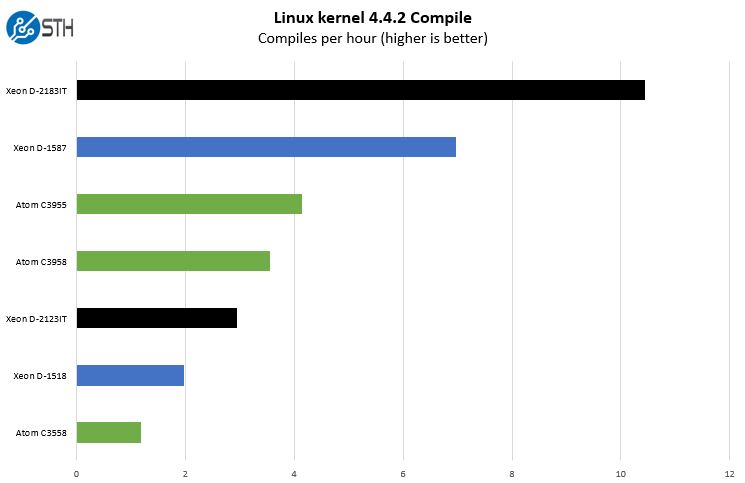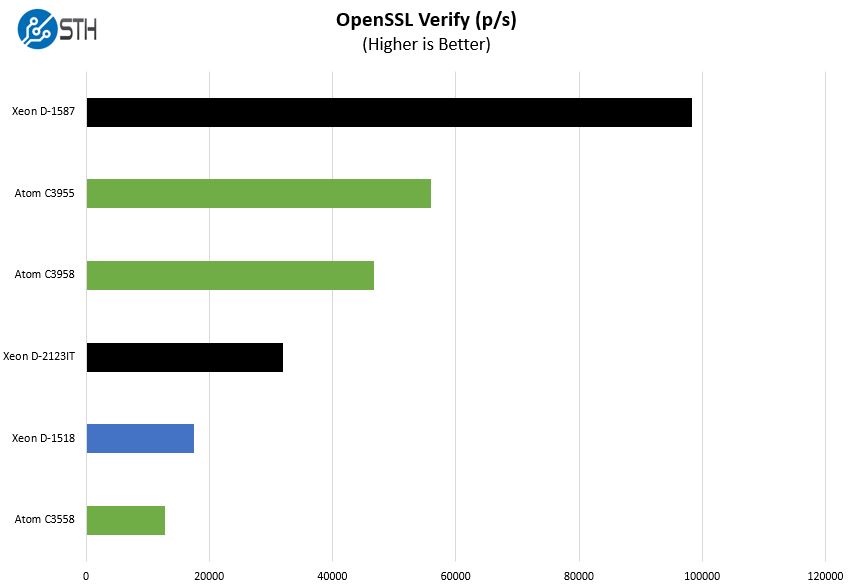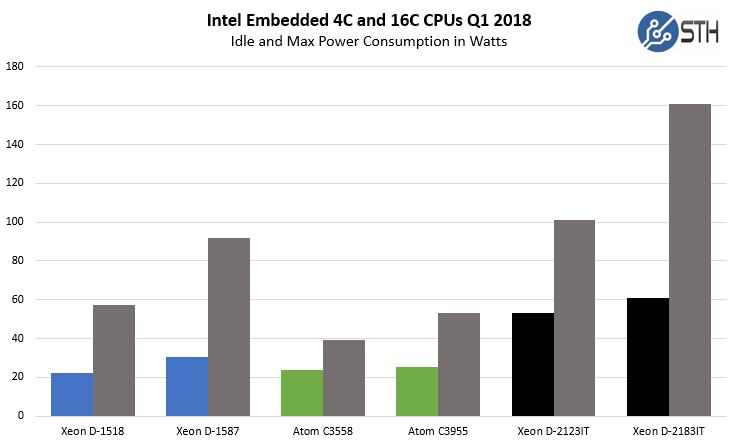Supermicro X11SDV-4C-TLN2F Performance
We wanted to provide a few data points to show just how much faster the new 4 core / 8 thread Intel Xeon D-2123IT solution is versus the previous generation Xeon D-1518 4 core / 8 thread model. This is a decent way to look at the Supermicro X11SDV-4C-TLN2F versus the X10SDV generation of embedded platforms from the company. We also have the Atom C3000 series and 16 core models represented to show what the ranges are for the different series.
One benchmark we typically use for this is our Linux kernel compile benchmark. This touches a decent amount of the total system performance factors and is something many Linux admins and developers have the first-hand experience with.

As you can see, the higher power and thermal envelopes, higher clock speeds, additional memory bandwidth, and more robust cache structures allow the Xeon D-2123T on the Supermicro X11SDV-4C-TLN2F series parts to show off performance versus the previous generation.
Here is a good example of non-QAT accelerated OpenSSL Verify tests on the same set of CPUs:

We see generally the same pattern as we saw in our previous results with the new SoC performing about twice as fast as the previous generation.
These are just two performance data points, but they highlight the general trend we are seeing. The X11SDV core-for-core is significantly faster than the X10SDV generation parts.
While it is a more robust platform, more performance can mean more power consumption which we recorded during our testing.
Supermicro X11SDV-4C-TLN2F Power Consumption
In terms of power consumption, we wanted to give a view that shows the idle and maximum observed power consumption of the Supermicro X11SDV-4C-TLN2F compared to other embedded solutions at 4 core and 16 core levels.

Here the Supermicro X11SDV-4C-TLN2F is the set of bars represented by the Xeon D-2123IT. As you can see, the significantly better performance comes at a cost of more power consumption. The larger heatsink we saw is necessary for the new platform. We saw our 60% load figures around 81W.
Final Words
At the end of the day, this is progress in the Intel Xeon D product family. You can see how Supermicro has tailored its solution to take advantage of the high power Xeon D-2123IT that simply has features that the previous generation lacks. The Supermicro X11SDV-4C-TLN2F is a great all-around motherboard but we feel that instead of replacing the Supermicro X10SDV-4C-TLN2F, it is instead a complementary part that trades additional power consumption for more functionality and performance.




Can’t wait for AMD’s Embedded Epyc to hit the market. Hopefully that will drive perfromance plus I/O up and prices down.
I don’t really understand why idle watts are so high. I would almost guess SoC doesn’t reach its deepest power saving states, which should be fixed after kernel support matures.
I second the yearn for AMD Epyc Embedded boards. Beside that, looking at the charts above, the best bang per watt and bucket still seems to be at Atom C3955. At least for my usage scenario and feature set needs.
@Jyrki:
I would say kernel support should be pretty solid since it’s based on the Skylake Platform and Intel usually gets their drivers in pretty early. Maybe using acpi-cpufreq instead of intel pstate helps, I usually use the schedutil governor on my Intel devices.
However I don’t know how many of the other platforms also have out of band management, I believe that AST2500 is also drawing some power.
What I would really like to see is a similar platform that offers more PCIe lanes and/or better networking in the SoC.
Expected price? 1000$+?
I would be shocked if they were that high for the 4C models.
Pricing looks to be around $700.
https://www.gamepc.com/shop/products?sku=X11SDV-4C-TLN2F
Does anyone know where to get an OCulink to 4X SATA cable?
This is the only place I have been able to find one and they require a minimum order of 25
https://www.serialcables.com/largeview.asp?cat=359&tier=264&id=1788
Hello Patrick,
Thank you for the review! I have a quick question for you – do you think that a GPU would fit in the PCIe slot? And if so, is the slot in the right position for a typical mITX case?
Thanks!
Likely the correct position. It may depend on the GPU used in terms of space.
Hi Patrick, all,
Would anyone know what the status of the X11SDV-4C-TLN2F mobo is as of June 2018? It’s quite hard to find anywhere, and some stores even listed as discontinued.
Is this a product that you’d still advise buying?
Thanks for any help!
Hi Juan, I see these in stock at a number of places online as of 9 June 2018
Hey Patrick,
Thanks for the quick reply! So do I, but at wildly varying prices, and unavailable at some major retailers like Amazon, with some of them listing the item as discontinued. That’s why I was wondering if there was something wrong with the item, e.g. if it’d been recalled due to some defect or something, because I find it odd that Supermicro would discontinue an X11 mobo (if it actually did) when most (if not all) X10 mobos are still available for purchase almost everywhere.
Do you happen to know anything about that? Thanks!
Hi Juan – I have not heard of a D-2100 issue to date. Amazon is not a primary retail outlet for SM gear. Often if you look at secondary retailer pricing it is wildly different.
Hi Patrick,
Thanks for the info and confirmation. I feel more confident now purchasing this mobo.
Hi Patrick,
If I may throw another question at you about this board after a while… what case did you use it in? I wanted to use it for a cold storage & backups NAS (i.e. low activity, hardly any more than receiving hourly ZFS replication streams and bi-monthly pool scrubbing), so I was hoping to put it in Supermicro’s CSE-721TQ-250B Mini-Tower, which I understand you’ve reviewed separately. But Supermicro itself told me this was a bad idea because that case would not be able to handle all of the undissipated heat generated by the built-in chip & the provided passive cooling, recommending that I stick to prior generation’s X10SDV-4C+-TLN4F equivalent, which is actively cooled. I don’t care much for 4 NICS, but I do for 10GbE networking (and storage performance, which if I read you right in this article, you say it’s been improved in the X11).
So, with that in mind, what chassis would you recommend for this board? Or, alternatively, what alternative board would you suggest?
Thanks!
Hi, I bought mine at Provantage. I received it about 3 weeks ago. The board is outstanding. Very happy with it.
http://www.provantage.com/supermicro-mbdx11sdv4ctln2fo~7SUPM5WU.htm
For those looking for a homelab solution I would recommend waiting for the X11SDV-4C-TP8F to be released, hopefully for around the same price as it’s ITX brother. You’ll get significantly better features at the uATX form factor
Quick question – since this doesn’t have M.2 how exactly do you hook up internal SSD storage via Ocusync? Do you just get a 2.5″ SSD and order the Supermicro OCuLink to U.2 PCIE SFF-8639 with Power Cable (CBL-SAST-0956)? If so then you need to buy the super pricy SSD with u.2 connection because most have SATA? or do you need to do the above cable AND buy an M.2 plus StarTech.com M.2 to U.2 Adapter? Seems hokey.
U.2 is the better standard. It allows features like NVMe hot swap and backplanes. You can also get power loss protection in large capacity SSDs with U.2.
You are right that not supporting M.2 directly means using consumer SSDs in your server is harder. U.2 is the better standard for a server. Price wise, check the STH forums. Usually one can get U.2 drives for about the same as M.2 but with more features.
I am using CSE-721TQ-250B and my biggest issue right now is actually the power. The case doesn’t come with an 8pin ATX. Just 2 4-pins. It will boot with just the 4pin plugged in but it keeps having the server shut off randomly.
Is there a DC PSU that is recommended?
Would the stock 250w power supply be enough for this board?
i just want 5000-7000+ passmark CPU on a dual NIC board that PFsense will run on that doesn’t cost a kidney.
Ob Highroller oder Hobby-Spieler – ganz gleich, was das Spieler-Herz begehrt, in unserem Online Casino finden auch Sie Ihr Lieblingsspiel.
In unserem Online Casino finden Sie die beliebten Fruit-Slots, abenteuerliche Walzen, magische Jackpots.
Gewinnen Sie Münzen und spielen Sie für RIESIGE progressive Jackpots an den besten Slots, darunter Jungle Wild, Zeus
II, Feuerstein, Fu Dao Le, Buffalo Spirit, Gorilla Chief,
Kronos: Vater des Zeus, Lock it Link, Dragon Spin und Invaders from the Planet Moolah!
Eine weitere Möglichkeit, die besten Echtgeld Casinos von den schlechten zu unterscheiden, ist, ob es einen Bereich gibt, im Sie Live
spielen können. Die Spiele bieten weder “Echtgeld-Glücksspiel”
noch die Möglichkeit, Echtgeld oder Preise zu gewinnen. So geht dies wie
auch dann, wenn man als Mitglied Geburtstag
hat, sich zur bestimmten Zeit einen Account einrichtet oder bei Gewinnspielen Preise ergattert.
Note: Guest account does NOT merge with Facebook account.
Hey party people! It’s time to let the fun begin with a
thrilling and authentic gaming experience.